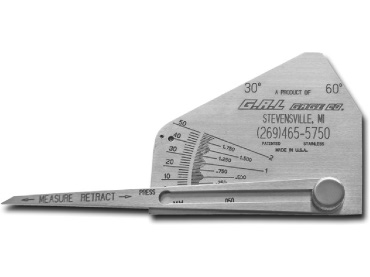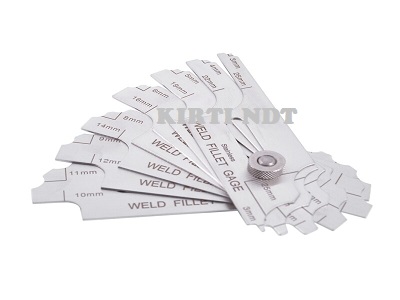Innovative Methods to Fillet Weld Evaluation and Screening: Enhancing Weld Quality and Conformity Standards
In the world of welding, the high quality and integrity of fillet welds play a vital role in making certain the architectural soundness and reliability of numerous commercial components. With the consistent drive for improved performance and compliance with stringent requirements, the exploration of innovative approaches to fillet weld examination and testing has actually become imperative.
Advanced Non-Destructive Screening Approaches
Making use of cutting edge technologies, progressed non-destructive screening methods play a critical role in ensuring the honesty and high quality of fillet welds. These methods, such as phased range ultrasonic screening (PAUT) and magnetic bit screening (MPT), offer thorough insights right into the weld's inner structure without triggering any kind of damage to the material. PAUT, as an example, utilizes multiple ultrasonic aspects to inspect the weld from numerous angles, providing a detailed visualization of possible problems like absence of blend or cracks.
By employing these advanced non-destructive screening strategies, weld assessors can properly analyze the top quality of fillet welds, guaranteeing compliance with industry criteria and laws. The capability to identify imperfections early on not just improves weld high quality however also prevents expensive rework or failures in structural integrity, underscoring the value of these cutting-edge screening techniques in welding evaluations.
Robotics and Automation in Inspection

The combination of robotics and automation has revolutionized the inspection procedure for fillet welds, enhancing effectiveness and precision in high quality assessment. Robotics supply accurate control and repeatability in checking welds, making certain reputable and regular results. Automated systems can be programmed to adhere to details inspection paths, making certain comprehensive protection of welds and minimizing the danger of human error.
Robotic inspection systems equipped with sophisticated sensors can spot and determine weld features with high accuracy, providing in-depth data for evaluation. These systems can determine problems such as fractures, lack of combination, and porosity, allowing prompt corrective activities to be taken. Additionally, robotics and automation permit real-time data collection and evaluation, supplying instant comments to drivers and assisting in fast decision-making processes.
Furthermore, the usage of robotics and automation in fillet weld evaluation boosts total performance by minimizing inspection times and enhancing evaluation throughput. By enhancing the evaluation procedure, manufacturers can guarantee weld top quality and conformity standards are satisfied effectively, inevitably causing cost savings and enhanced product high quality.
Using Expert System for Analysis
Synthetic intelligence plays a pivotal function in enhancing the efficiency and precision of analysis in fillet weld inspection procedures. By harnessing the power of AI, examiners can simplify the analysis of weld top quality and compliance standards, resulting in more reputable and specific outcomes. AI algorithms can quickly process substantial quantities of data from weld examinations, spotting flaws or disparities that may be challenging to identify with the naked eye. This sophisticated modern technology makes it possible for real-time monitoring of weld high quality, permitting for immediate restorative actions to be taken if any kind of issues are detected.
Furthermore, AI systems can pick up from previous assessment information, constantly improving their capacity to recognize prospective flaws and variances in fillet welds. This adaptive learning ability improves the overall quality control process, lowering the possibility of human error and making certain that welds satisfy the called for requirements. By incorporating fabricated intelligence right into fillet weld analysis, markets can accomplish higher levels of effectiveness, uniformity, and compliance in their inspection practices.
Portable Devices for On-Site Inspection
Enhancing field examination efficiency, the fostering of portable devices reinvents on-site analysis processes for fillet welds. These devices use versatility and comfort, permitting assessors to perform detailed exams in numerous areas, consisting of remote or challenging atmospheres. Mobile tools such as ultrasonic testing tools, magnetic fragment evaluation devices, and digital radiography systems give real-time information and high-resolution imaging abilities, making it possible for quick decision-making and immediate responses on weld high quality.
One significant benefit of mobile tools is their capability to improve assessment treatments, minimizing downtime and boosting general efficiency - Gauge Fillet Weld. Examiners can quickly move these tools to different work websites, removing the requirement for transferring hefty machinery or components to off-site centers. Furthermore, the portability of these devices advertises cost-effectiveness by lessening transportation expenditures and increasing examination timelines
Furthermore, using mobile tools for on-site evaluation advertises proactive quality assurance measures, as assessors can without delay determine and attend to any type of possible welding defects or disparities. By integrating these ingenious modern technologies into on-site inspection methods, welding experts can make sure compliance with sector standards and boost weld quality, ultimately resulting in enhanced architectural integrity and safety and security in different welding applications.
Integration of Information Management Systems

Having actually maximized on-site examination processes through the usage of portable devices, the next stage entails the smooth assimilation of data monitoring systems to additionally enhance efficiency see this website and information evaluation her latest blog capacities in fillet weld evaluation and testing. By integrating data administration systems into the examination process, companies can simplify data collection, storage, and evaluation. This assimilation enables real-time monitoring of weld high quality, instant identification of issues, and timely decision-making to rectify any type of issues that may occur during the inspection procedure.
The assimilation of data monitoring systems makes it possible for seamless interaction between different stakeholders included in the evaluation process, cultivating cooperation and boosting general quality control measures. Ultimately, the integration of data management systems serves to boost the criteria of fillet weld examination and testing, making certain conformity with sector laws and boosting weld high quality.
Final Thought
In verdict, innovative techniques to fillet weld inspection and testing have significantly improved weld quality and compliance criteria. Advanced non-destructive screening methods, robotics, automation, synthetic knowledge, mobile devices, and information administration systems have revolutionized the method weld inspections are conducted. By utilizing these modern technologies, markets can ensure that welds satisfy the called for top quality requirements and laws, inevitably enhancing overall performance and security in welding processes.

Having actually optimized on-site inspection processes via the application of mobile devices, the next phase entails the smooth combination of information monitoring systems to even more enhance performance and data analysis abilities in fillet weld assessment and screening. Inevitably, the assimilation of information management systems offers to raise the standards of fillet weld evaluation and screening, guaranteeing conformity with industry guidelines and enhancing weld quality.
